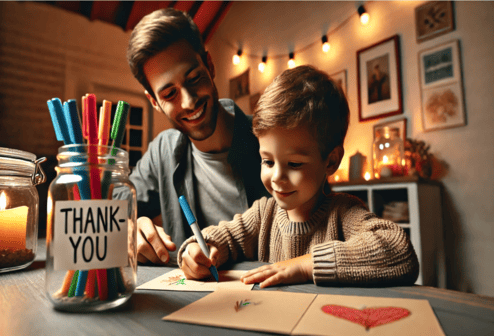Gratitude is more than just saying “thank you.” It’s a mindset that helps children appreciate what they have, recognize kindness, and develop a positive attitude toward life. Grateful children tend to be more empathetic, resilient, and optimistic.
In this article, you’ll learn practical, heart-centered ways to teach gratitude to children—helping them grow into thoughtful and appreciative individuals.
Why Gratitude Matters
Gratitude helps children:
- Build stronger relationships
- Cope with challenges more positively
- Develop emotional well-being
- Show kindness and empathy
- Reduce entitlement and increase generosity
And like most values, gratitude is best learned through daily practice and example.
Be a Role Model
Children learn gratitude by seeing it in action. Let them hear and see you express appreciation regularly.
- “Thank you for setting the table—that helped a lot.”
- “I’m grateful we had time to play together today.”
- “That was so kind of our neighbor to bring cookies!”
Your genuine expressions show that gratitude is a normal and joyful part of life.
Encourage Saying Thank You (With Meaning)
Teach children to say “thank you” sincerely, not just out of habit.
- Look the person in the eye
- Say what they’re thankful for: “Thank you for helping me build my tower!”
- Explain why it matters: “That made me feel really happy.”
Model this behavior and gently remind them in real-life situations.
Create a Daily Gratitude Ritual
Build gratitude into your daily rhythm with a simple routine, such as:
- Gratitude jar: Write something you’re thankful for each day and place it in the jar
- Bedtime reflection: Ask, “What was your favorite part of the day?” or “What are you thankful for today?”
- Family meal sharing: Go around the table and share one thing everyone is grateful for
These moments build awareness and appreciation in a natural, joyful way.
Talk About Giving and Receiving
Help your child understand how gratitude connects to kindness.
- When someone shares a toy, say, “Wasn’t that thoughtful?”
- When they receive a gift, talk about how it was chosen with love
- Involve them in making thank-you cards or phone calls
Understanding the why behind the thanks deepens the emotional impact.
Give Them Opportunities to Help
Children appreciate more when they contribute. Give them chances to:
- Help with household tasks
- Donate old toys or clothes
- Make a card or drawing for someone
- Participate in simple acts of service
These experiences build empathy and show them the joy of giving and receiving.
Tell Stories That Inspire Gratitude
Books and stories are powerful tools for exploring gratitude.
Look for books that highlight:
- Thankfulness
- Acts of kindness
- Appreciation of nature, family, or community
After reading, ask:
- “What was the character thankful for?”
- “What are you grateful for today?”
Stories make abstract values more relatable.
Avoid Overindulgence
Too many toys, treats, or constant “yes” can make gratitude harder to learn. It’s okay to say no sometimes and help your child wait or earn things.
- Focus on experiences, not things
- Celebrate effort and presence over gifts
- Help them recognize what they already have
Gratitude grows in moments of reflection, not in excess.
Celebrate Gratitude Publicly
When your child shows genuine appreciation, highlight it!
- “I noticed how you thanked your teacher—that was so respectful.”
- “You said thank you without being reminded. That shows you really meant it.”
- “That was a grateful heart in action!”
Reinforcing these moments helps them take pride in their kindness.
Final Thoughts: Gratitude Is a Gift That Grows
Teaching gratitude isn’t about forcing thank-you’s—it’s about cultivating awareness, presence, and joy. When you guide your child with love, model appreciation, and create simple rituals of thanks, you’re giving them a tool that will serve them for life.
Gratitude turns ordinary moments into treasures. And in helping your child see those treasures, you’re nurturing a heart full of wonder, generosity, and deep emotional strength.
